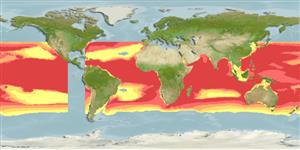Common names from other countries
>
Myctophiformes (Lanternfishes) >
Myctophidae (Lanternfishes) > Diaphinae
Etymology: Diaphus: Greek, dis, dia = through + Greek, physa, phyo = to beget, to have as offspring (Ref. 45335).
More on author: Gilbert.
Environment: milieu / climate zone / depth range / distribution range
Écologie
marin bathypélagique; profondeur 0 - 2091 m (Ref. 26165). Deep-water; 40°N - 49°S, 78°W - 99°W
Eastern Atlantic: Canary Islands (Ref. 6808) and off Senegal. Western Atlantic: west of 30°W between 36°N and 10°S. Indo-West Pacific: off East Africa, Comoro Islands and west coast of Madagascar; off Japan south of 40°N, southeast Asian seas, Australia (Ref. 7300) and New Zealand (Ref. 5755). Eastern Pacific: near Hawaii, and off Acapulco, Mexico. South China Sea (Ref.74511).
Length at first maturity / Taille / Poids / Âge
Maturity: Lm ?, range 4 - ? cm
Max length : 6.0 cm SL mâle / non sexé; (Ref. 4479)
Épines dorsales (Total) : 0; Rayons mous dorsaux (Total) : 15 - 16; Épines anales: 0; Rayons mous anaux: 14 - 17.
Meso- and benthopelagic (Ref. 58302). Pseudoceanic, at 325-750 m by day and nyctoepipelagic at surface to 125 m at night (with maximum abundance at 100 m) (Ref. 4479). Lipid content is 8.7 % in fresh body weight and wax ester is 1.7 in total lipids (Ref. 9193). Often appears with sergestid shrimp Sergia spp., marine hatchetfishes Argyropelecus spp. and Polyipnus spp. (Ref 39633).
Specimens reach sexual maturity at a length of 4 cm (Ref. 47377).
Life cycle and mating behavior
Maturities | Reproduction | Spawnings | Egg(s) | Fecundities | Larves
Hulley, P.A., 1990. Myctophidae. p. 398-467. In J.C. Quero, J.C. Hureau, C. Karrer, A. Post and L. Saldanha (eds.) Check-list of the fishes of the eastern tropical Atlantic (CLOFETA). JNICT, Lisbon; SEI; Paris; and UNESCO, Paris. Vol. 1. (Ref. 4479)
Statut dans la liste rouge de l'IUCN (Ref. 130435)
CITES (Ref. 128078)
Not Evaluated
Menace pour l'homme
Harmless
Utilisations par l'homme
Outils
Articles particuliers
Télécharger en XML
Sources Internet
Estimates based on models
Preferred temperature (Ref.
115969): 5.4 - 14.4, mean 8.6 (based on 1147 cells).
Phylogenetic diversity index (Ref.
82804): PD
50 = 0.5000 [Uniqueness, from 0.5 = low to 2.0 = high].
Bayesian length-weight: a=0.00646 (0.00351 - 0.01187), b=2.97 (2.81 - 3.13), in cm Total Length, based on LWR estimates for this species & Genus-body shape (Ref.
93245).
Niveau trophique (Ref.
69278): 3.1 ±0.3 se; based on size and trophs of closest relatives
Résilience (Ref.
120179): Haut, temps minimum de doublement de population inférieur à 15 mois (Preliminary K or Fecundity.).
Fishing Vulnerability (Ref.
59153): Low vulnerability (10 of 100).
